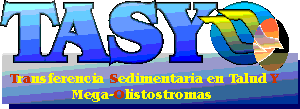 Back to TASYO recent papers
Back to TASYO recent papers
M. Catalán 1, A. Carbó 2, A. Muñoz 2, T. Medialdea
3, J.T. Vazquez 4, L. Somoza 3
1 Sección de Geofísica, Real Instituto y Observatorio
de la Armada, San Fernando 11100 (Cádiz). mcatalan@roa.es
2 Dpto. de Geodinámica, Fac. de Geología, Univ. Complutense,
Madrid 28040..
3 Instituto Tecnológico y GeoMinero de España. C/Rios
Rosas 23. E-28003 Madrid.
4 Universidad de Cádiz. Campus Río San Pedro s/n. E-11510.
Puerto Real.
Keywords
Continent-Ocean Boundary, gravity and magnetic sea anomalies, Gulf
of Cadiz.
The Gulf of Cádiz is located at southwest of the Iberian Peninsula. Its tectonic history has been conditioned mainly by two facts: the northwest Atlantic seafloor spreading, and the convergence between Eurasia and Africa.
During 2000, a marine geophysical cruise has been developed [TASYO]. It was carried out from April to May, using as scientific platform the R/V “Hespérides”. This campaign was divided in two parts. In the first one, it was acquired geomagnetism, earth gravity field data, and bathymetry. All along September 2000, a latter cruise [ANASTASYA] on board of the Oceanographic vessel “Cornide de Saavedra” was developed. Both cruises have provided new information mainly based on potential fields (gravity and geomagnetism), concerning a large NE-SW trending geological feature, called Guadalquivir Bank.
During the second part of TASYO campaign, it was described a zig-zag
like trackline pattern that penetrate into Eastern Atlantic Ocean., collecting
not only the three above mentioned disciplines but also, multichannel seismic
data.
The Ocean-Continent transition could be identified as that part of
the lithosphere which links a thinned continental crust and the first oceanic
crust formed by seafloor spreading. This concept is not everywhere outlined
correctly. As it has been pointed out by several authors, this transitional
area is important because it contains evidence concerning the break up
of the Continents and the onset of seafloor spreading.
During the last decade the nature of the Ocean-Continent transition off western Iberia has attracted the attention of several groups. The following studies demonstrate the importance of this subject: Whitmarsh et al. (1990), Pinheiro et al. (1992), Whitmarsh and Miles (1995), and Chian et al. (1999).
They followed seismic as well as other geophysical studies concerning the Iberia Abyssal Plain, Tagus Abyssal Plain and the Galicia Bank. Maybe due to its complex tectonic evolution, and the additional difficult produced by the presence of the chaotic allochthonous unit, known as Olitostrome, this problem has never been achieved at the Gulf of Cádiz.
In this comunication a multidisciplinary approachment to this problem
(gravity, geomagnetism and multichannel seismic), is going to be performed.
Its possible location in the Gulf of Cádiz, using information provided
by the zig-zag like trackline pattern of the Tasyo cruise is going to be
discussed.
Whitmarsh R.B., P.R. Miles, Mauffret A., “The ocean-boundary off the
western continental margin of Iberia –I. Crustal structure at 40º30’N”.
Geophys. J. Int., 103, 509-531. 1990
Pinheiro L.M, Whitmarsh R.B., P.R. Miles, “The ocean-boundary off the
western continental margin of Iberia –II. Crustal structure in the Tagus
Abyssal Plain”. Geophys. J. Int., 109, 106-124. 1992
Whitmarsh R.B., P.R. Miles, “Models of the development of the West
Iberia rifted continental margin at 40º30’N deduced from surface and
depp-tow magnetic anomalies”. J. Geophys. Res., 100, No.B3, 3789-3806,
1995
Chian D., Louden K. E., Minshull T.M., Whitmarsh R.B., “Deep structure
of the ocean-continent transition in the southern Iberia Abyssal Plain
from seismic refraction profiles: Ocean Drilling Program (Legs 149 and
173) transect”. J. Geophys. Res., 104, No.B4, 7443-7462, 1999